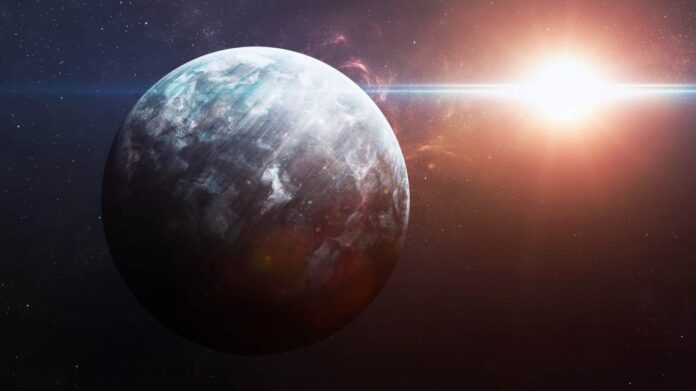In 2006, the International Astronomical Union (IAU) officially demoted Pluto from the beloved ninth planet to one of five dwarf planets; the universe hasn’t felt the same since. An impressive backlash followed, still brewing within the scientific community.
Ten years later, an article in The Astronomical Journal argued for the existence of Planet Nine because of the altered orbits of nearby space bodies (e.g., comets, asteroids, moons, dwarf planets, etc.). Essentially, something significant acts on their gravity, although it sits too far from the sun to be seen via solar light rays.
Now, a new study may set the stage for Planet Nine’s discovery, hypothesizing that roughly 20 superheated moons orbit it. Seeing these tiny satellites would prove impossible. But due to their high temperatures, one researcher believes they give off weak radio signals capable of telescopic detection. As a result, some astronomers have launched a hunt for hot moons in our area (of the galaxy).
The Outer Solar System’s Massive Ice Giant
While the thought of a giant Planet Nine orbiting at the edge of our solar system might sound sensational (and unthinkable), some believe science firmly backs it. They include Konstantin Batygin of Cal Tech and Mike Brown of the California Institute of Technology, co-writers of the 2016 Planet Nine hypothesis. Brown explains, “It’s not crazy; this is the kind of stuff people are finding all the time. We just need to go out and cover a good swath of the sky.”
Where does Pluto fit into all of this? Everyone’s favorite dwarf planet also sits at the Kuiper Belt’s edge, but it doesn’t have the gravitational pull to explain what’s happening with affected space objects in the area. And Batygin and Brown determined that the solar system’s other giant planets all prove too far away to be culprits. The apparent conclusion? A ninth planet may lurk in the farthest corners of our galaxy.
What We Know About So-Called Planet Nine
If Planet Nine does exist, what do we know about it so far? Scientists estimate it could be between five and ten times the mass of Earth. Moreover, they’ve proposed an elongated orbit for the giant that travels up to 400 times our planet’s distance from the sun. They also believe that, unlike most planets in our solar system, the ice giant may sit 15 to 25 degrees off the main orbital plain.
But these revelations have done little to prove the actual existence of the planet. (Some scientists even claim Planet Nine is a black hole.) To date, the most damaging indictment against the planet remains a total lack of light signatures. But considering its distance from the sun, astronomers who support the Planet Nine theory aren’t surprised.
Why Superheated Moons May Change Everything
Until recently, scientists assumed the only way to prove Planet Nine’s existence was through its eclipse of a distant light source. Think a star or galaxy within the Milky Way. That’s why the recent theory about superheated moons giving off faint radio signals proves so exciting. After all, if scientists know what to look for, they can attune telescopes accordingly.

Radio satellite dishes used to pick up faint signals. via Shutterstock
Detecting these signals would prove easier than crossing our fingers and hoping for an eclipse. Man Ho Chan of the University of Hong Kong developed the superheated moon theory by calculating the maximum number of satellites Planet Nine might support. His final figure came in at 20 moons, measuring up to 62 miles across — small beans for astronomers squinting through telescopes. But, nonetheless, a trail of potential planetary breadcrumbs.
Tidal Heating, Radio Signals, and the Fate of Pluto
Thankfully, Planet Nine’s gravitational pull may provide more clues to its existence through a phenomenon known as tidal heating. We know about tidal heating because of Jupiter’s moon, Io, featuring a highly molten core fueled by the intense gravitational tug-of-war it endures with Jupiter and the planet’s other moons.
If Planet Nine does exist, and tiny moons orbit it, they would be subject to tidal heating, too. Chan estimates their temperatures might come in at approximately 280 degrees Fahrenheit. Compared to the average temperature of outer space, -455 degrees Fahrenheit, that’s a significant temperature increase. Heated to these extremes, the moons would emit radio signals, providing clear evidence of their existence and the giant they circle.
If and when Planet Nine’s hot moons get discovered via radio signals, this begs the question, what should we name it? Astronomers tend to prize consistency and tradition, hence the multi-generational use of Greek and Roman god and goddess monikers (e.g., Venus, Mars, Neptune). But Jean-Luc Margot of UCLA is already lobbying to stick with “Planet Nine,” which would buck trends but has a certain ring to it. Moreover, a title like Planet Nine allows poor, diminutive Pluto to remain forever in our hearts if not in our solar system’s giant planets model.
By Engrid Barnett, contributor for Ripleys.com
EXPLORE THE ODD IN PERSON!
Hits: 0










